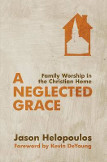Posts by Nick Batzig

When Jesus explained the nature of His atoning death on the cross to the Israelites of His day, He appealed to what is arguably the most fascinating of the redemptive symbols from the history of Israel's wilderness wandering--namely, the bronze serpent on the pole (Numbers 21:4-9; John 3:14). The bronze serpent is the clearest type of the saving work of Jesus at Calvary. Of all the types and shadows, there was not any that showed forth the principal work of the Savior better than this type. Jesus could have pointed to the passover, or to any of the sacrificial types that foreshadowed His atoning death, but He chose to point to this type in his discussion with Nicodemus.

Jesus is the second Adam undoing what Adam did and doing what Adam failed to do (Rom. 5:12-21; 1 Cor. 15:47-49). He is the Heavenly Bridegroom, entering into His sufferings in a Garden for the redemption of His bride, the Church. He is the Heavenly Gardener, giving Himself to the cultivation of the souls of His people through His atoning sacrifice and continual intercession. When He hung on the cross, He spoke of Glory under the name of "Paradise"--an evident allusion to the paradise in which our first parents dwelt and the paradise from which they fell. He is the second Adam who, by the shedding of His blood, secured the New Creation. As we consider the double entendres of the fourth Gospel, we come to those specifically concerning the biblical theology of the second Adam in the Garden.

There are two theological truths that structure the entirety of the biblical storyline. The first is that Jesus is the second and last Adam. The second is that Jesus is the true and greater Israel. The totality of the biblical narrative can be understood in light of these two theological categories. Additionally, the whole of the Gospel is structured by these two great truths. Jesus is the sin-bearing, curse-removing second Adam and true Israel. While much has been written on the former, until recent years the latter has been largely overlooked. Matthew 2:14-15 indicates that Jesus came to recapitulate Israel's history in order to fulfill the covenant promises for His people. Just as "He came to undo what Adam did and to do what Adam failed to do," so "He came to undo what Israel did and to do what Israel failed to do" as the representative of His elect.

When Paul says of Christ, in Galatians 3:13, that He "became a curse for us," this carries with it a world of biblical and theological meaning. Surely, the Apostle had the curse of the Mosaic Covenant in mind--as the context indicates; but what lay behind the covenant curses of the Mosaic Law was the curse of the broken Covenant of Works stretching all the way back to Adam--our federal representative--in the Garden. When we start to examine the biblical storyline, we start to see how all the pieces fall together as God directs our attention to the Second Adam and true Israel, Jesus Christ, who became the representative curse for us so that those who believe in Him might receive all the spiritual and eternal blessings of God.

In seminary, a friend of mine would often challenge me on my insistence that whatever portion of Scripture we preach, we ought to get our hearers to the cross. Whether we are preaching glorious cross-centered texts like Galatians 2:20-3:1 or Romans 5:6-11 or whether we are preaching any given part of the Sermon on the Mount, the minster must get his hearers to the cross for pardon and power. On one occasion, my friend responded by suggesting that we don't have to do so because "Jesus didn't do so." He said, "Jesus preached lots of things without mentioning His atoning work on the cross." So how should one respond to such a claim? I would suggest that a biblical-theological approach to reading the Scriptures contains the answer to such a faulty understanding of the message of Scripture.



















 © Alliance of Confessing Evangelicals
© Alliance of Confessing Evangelicals


